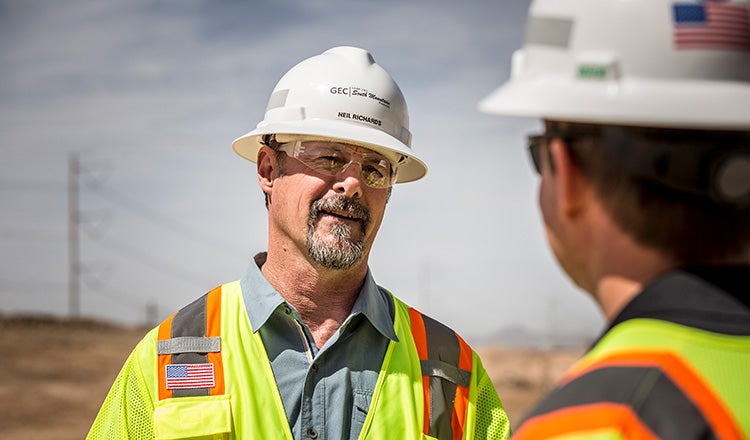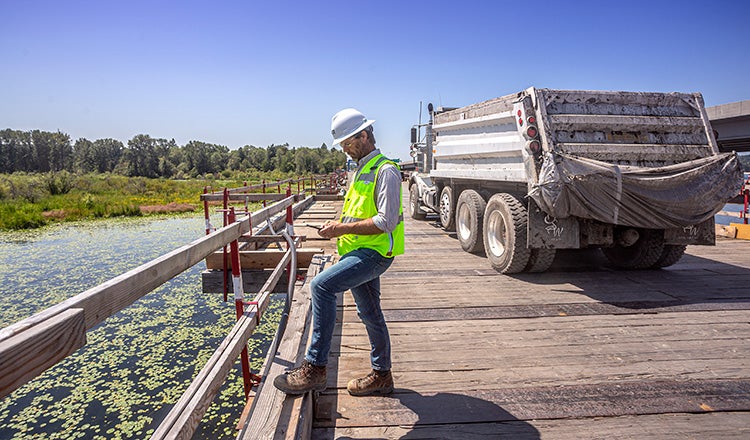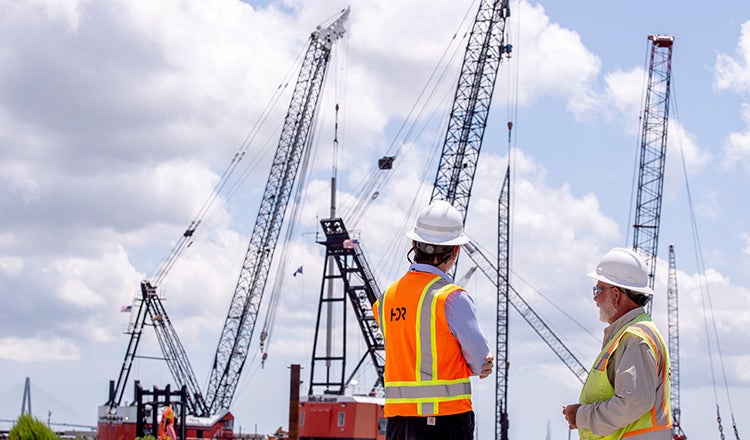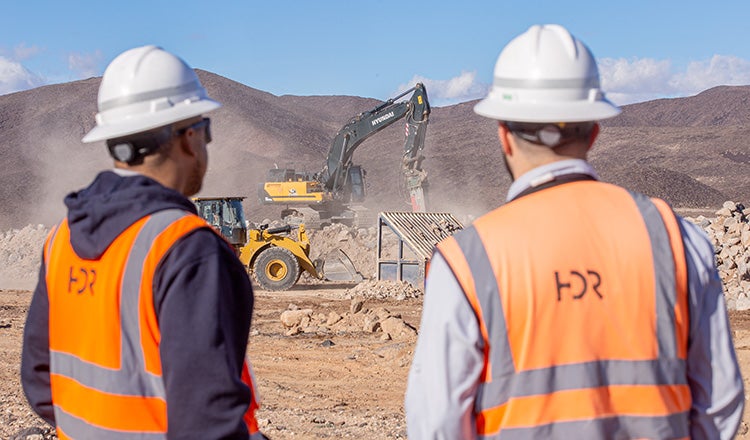
Experts Talk: Opportunities in Transportation Construction Services with Neil Richards
Experts Talk is an interview series with technical leaders from across our transportation program.
Why Experienced Construction Managers Are Needed More Than Ever
Construction services professionals act as the on-site eyes and ears of owners. These experienced specialists anticipate issues and identify concerns before they become crises. With hundreds of billions of dollars in infrastructure construction happening each year in North America, that skill and expertise is essential for keeping projects and programs on track and avoiding unnecessary costs and delays.
Neil Richards is the professional services director for construction and a senior transportation construction engineer. With more than 30 years in the industry, his construction management and operations leadership experience has contributed to the success of projects across the United States. His transportation experience includes both urban and rural highway projects, using traditional as well as alternative delivery methods.
In this interview, Neil discusses the attributes of a successful construction services professional, whether working in construction engineering and inspection, construction administration, construction management or a similar role. He also addresses the importance of keeping employees in the field connected to company culture and the changes he’s seen over his decades in the industry.

Q. What does it take to thrive in construction services?
A. Throughout my career, the people that do well in construction services have been those who can adapt to change. That’s true for many specialties, but especially in the construction world, where projects complete the delivery cycle and come to an end. The work lasts for a limited length of time and then professionals move on to the next opportunity. That often means physical relocation, especially as you get further in your career. The people in construction management who have been most successful have been adept at managing that change.
In addition, our profession has seen some remarkable technical change over the past decades, and I don’t expect that change to slow down. Digital design, for example, is creating opportunities for improved accuracy but also requiring expertise with technical tools that didn’t exist until recently.
In the same vein, while it’s important for construction professionals to be flexible, it’s important to note that there’s also more than one way to build a strong construction services career. One thing I’ve really appreciated about HDR is that they recognize the value of different skillsets.
Many people in this field start out as technical professionals, focused on projects and delivering the day-in-day-out work that advances construction projects. I decided about 10 years into my own career that rather than focus solely on technical work, I wanted to pursue a leadership and management track on the business side of things. When I came to HDR nearly 20 years ago, I largely transitioned out of project work. Instead, I helped organize staff, oversaw work quality and pursued new work. Eventually I did go back to a project role for a few years when the opportunity presented itself (again, adapting to change), but I appreciated that the firm recognizes that leadership roles are of commensurate value with technical expertise.

Q. How can we keep construction and field services staff connected to wider company culture?
A. When construction services employees work on a project, it’s often out of a field office on site, not in a company office. Essentially, these project offices function like little islands, and so one of the challenges for leadership is making sure that the people on that island still feel connected back with the mainland, so to speak.
We can’t make everything the same for every employee. But we try hard to bring HDR’s culture of valuing our employees to every project site. That can mean making sure construction teams have a place set aside to view company-wide meetings together, for instance, just as at the main office. Or setting up brown bag presentations at sites instead of just at corporate offices. As leaders, we also encourage everybody to participate in the local holiday parties or summer picnics or volunteer opportunities, times when they can meet and interact with their fellow HDR employees who they may see less frequently or only by video.
Our team-building culture has even extended to our relationships with other firms. Often on project sites we’re partnered with people from client agencies or other firms. We tend to take a leadership role in building a collaborative team environment where everybody feels valued and part of the team. That’s a natural part of our own company culture and it also creates teams that deliver better work for our clients.
Q. How have you seen construction services change in your decades in the industry?
A. Technology has radically evolved, in both design and construction. People in my generation started in the business using pen and paper and field books. But we’re now doing more and more with models and digital delivery. For example, for roadway construction, precise earthwork models are loaded into a scraper to guide the machine, providing accuracy that’s far improved. The ability to navigate the digital world is definitely going to be key to being successful in the future.
That said, while the technology exists and is available, in many cases agencies are still updating their standard contract language. That can lead to us having a delivery method that's appropriate from an efficiency standpoint but using contracting criteria that hasn’t adapted fast enough to catch up with the technology. The method of measurement and the basis of payment don’t necessarily align with how we’re actually delivering the work. How all of this gets integrated can be a challenge. That points to the importance of having experienced construction services professionals on site to navigate the gray areas.

Q. With all this new technology, why do we still need to have construction services professionals on site?
A. Yes, there’s lots of great technology. But quality assurance and human involvement is still critically important. It’s important that we still have experienced people who understand the whole process and can provide needed quality checks.
We may get to the point where somebody or something (like an unmanned aerial vehicle) can visit a site and use a camera to scan a rebar layout, then automatically compare it to the model. We’re already seeing projects where a drone is used to generate earthwork estimates as an ongoing progress check, for instance. The technology continues to advance and be integrated in new ways. But I believe there’s always going to be a place for skilled, knowledgeable people on-site. If nothing else, they will be needed to evaluate the items identified by technology as a variance or discrepancy. It will still require somebody to go out and look at something in person and say, “Yes, this needs to be fixed,” or “No, that’s not an issue.”
We all want to be able to turn to our colleague and say, “Does this look right?” That in-person communication will still be necessary. Very frequently, elements must be interpreted when it comes to their level of conformance to a set of plans and what's critical. A knowledgeable and skilled person is needed to decide where there is some elasticity. It takes people with an understanding of what the intent is to be able to guide that.
When I think of the importance of having humans on site, I’m reminded of a project I was on years ago, building a bridge. We were inspecting the casting of a bridge deck overnight — a fairly standard process. The previous day we performed one of the final preplacement checks, a dry run with the concrete finishing machine. All seemed well. But what we did not ask the guy driving the machine was “Do you know how to ‘operate’ the machine?”
There are augers on the front of the machine, and it turns out that the operator had the augers set incorrectly. He had the augers running backwards, pulling concrete up under the machine, and it actually lifted the machine off the rails. In all my time in construction, I’ve never before had to question whether an operator knew how to use the equipment. It’s not the construction engineering and inspection staff’s responsibility to direct the contractor, but we were telling the contractor foreman repeatedly that something was definitely wrong. The contractor eventually stopped. It was a very expensive mistake. But having people on site who understood how the process was supposed to work helped reduce the damage.

Q. How are you working to impart construction services expertise to the next generation?
A. One of our major efforts right now is a focus on internal training for our field services staff. I’ve been working with HDR’s learning and organizational development professionals to put together courses for field inspectors, resident engineers, bridge construction inspectors and more. We’ve really ramped up that effort in the past few years, both to invest in the advancement of our own staff as well as continue HDR’s focus on consistent quality work, no matter which office is providing expertise.
I’m also trying hard to emphasize the importance of client service and quality, which are primary initiatives here at HDR. That effort can be complicated by the scope and size of our services. We have people working for transportation agencies across North America, and each of them do things in slightly different ways. Keeping people abreast of those different guidelines to meet client obligations is part of our internal training. But as an employee-owned company we also have an obligation to our colleagues. We deliver quality not only to serve our clients but also to serve our fellow employee-owners.
Inspiration & Advice
Q. How did you end up with a career in construction services?
A. Construction services combine two things I really appreciate in a job: real world problem solving and a changing environment. I wasn't cut out to sit at a desk all day every day. I like that construction offers ongoing change in locations and projects, while also developing tangible solutions in the world around us.
Q. What advice do you have for someone interested in taking a similar career path?
A. Say YES! When an “opportunity” presents itself (often as a problem or a challenge), say yes to the opportunity to try to tackle it. These “stretches” are generally the times that really expanded my career.
Each Experts Talk interview illuminates a different aspect of transportation infrastructure planning, design and delivery. Check back regularly to discover new insights from the specialized experts and thought leaders behind our award-winning, full service consulting practice.




